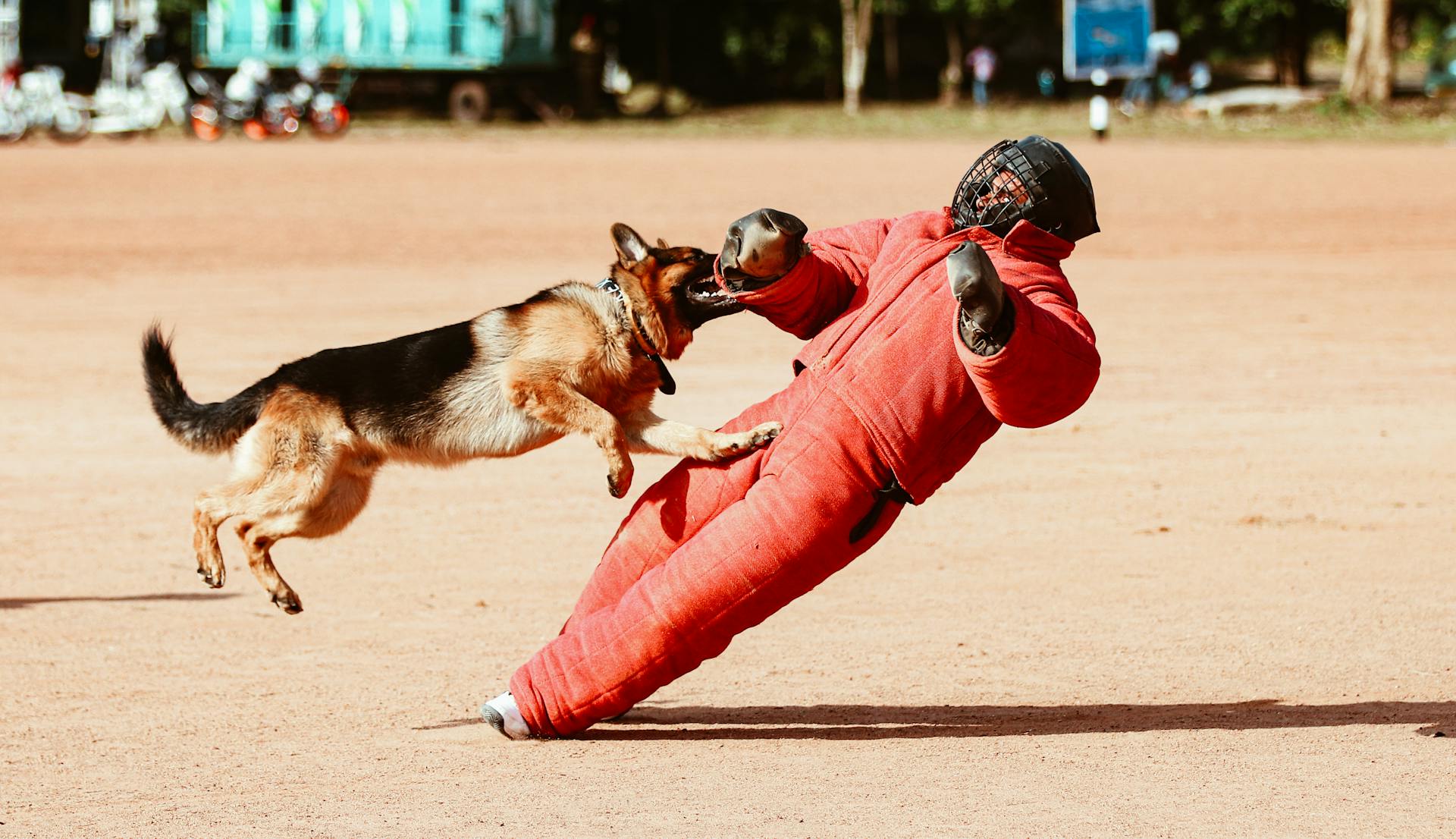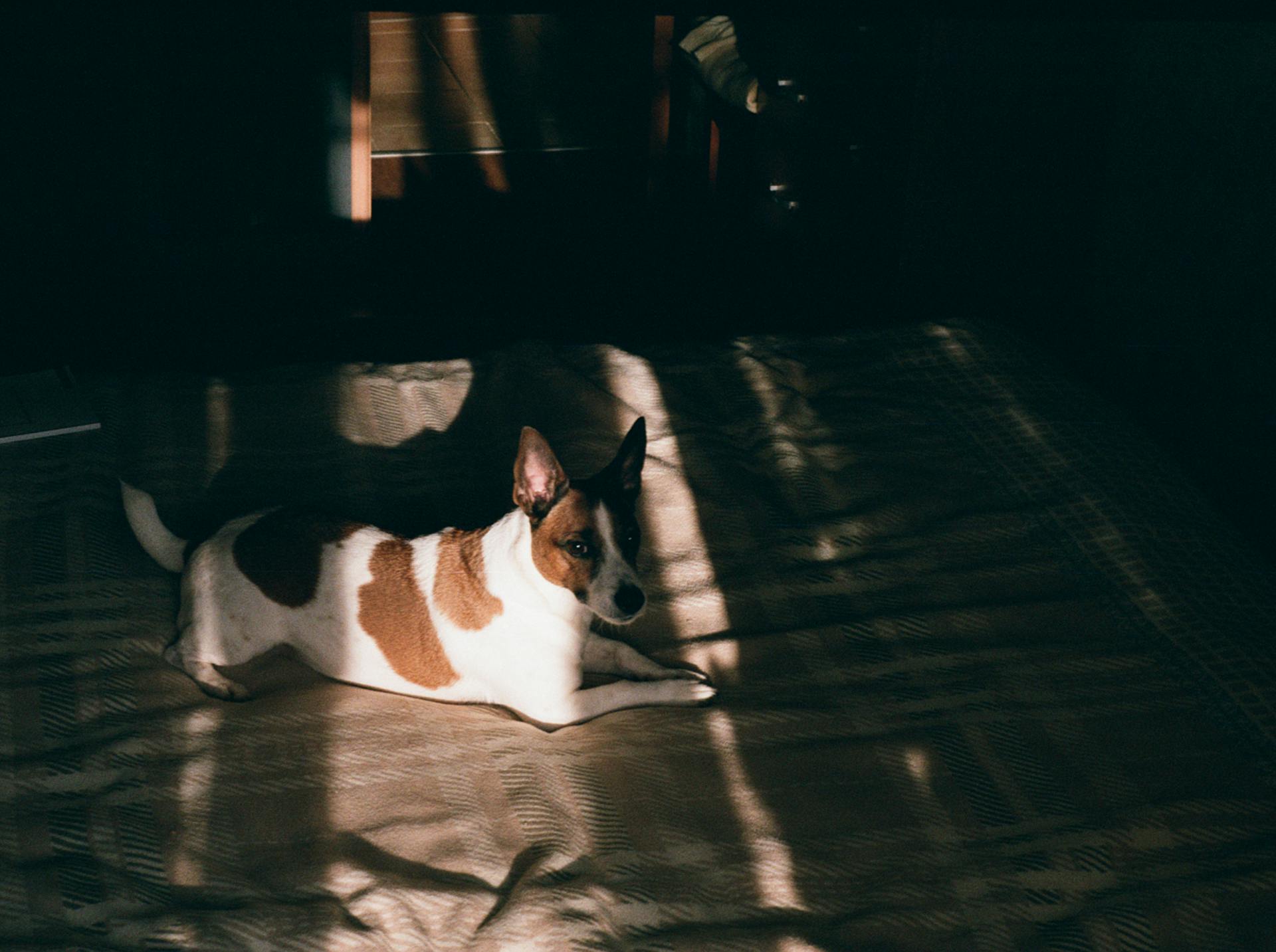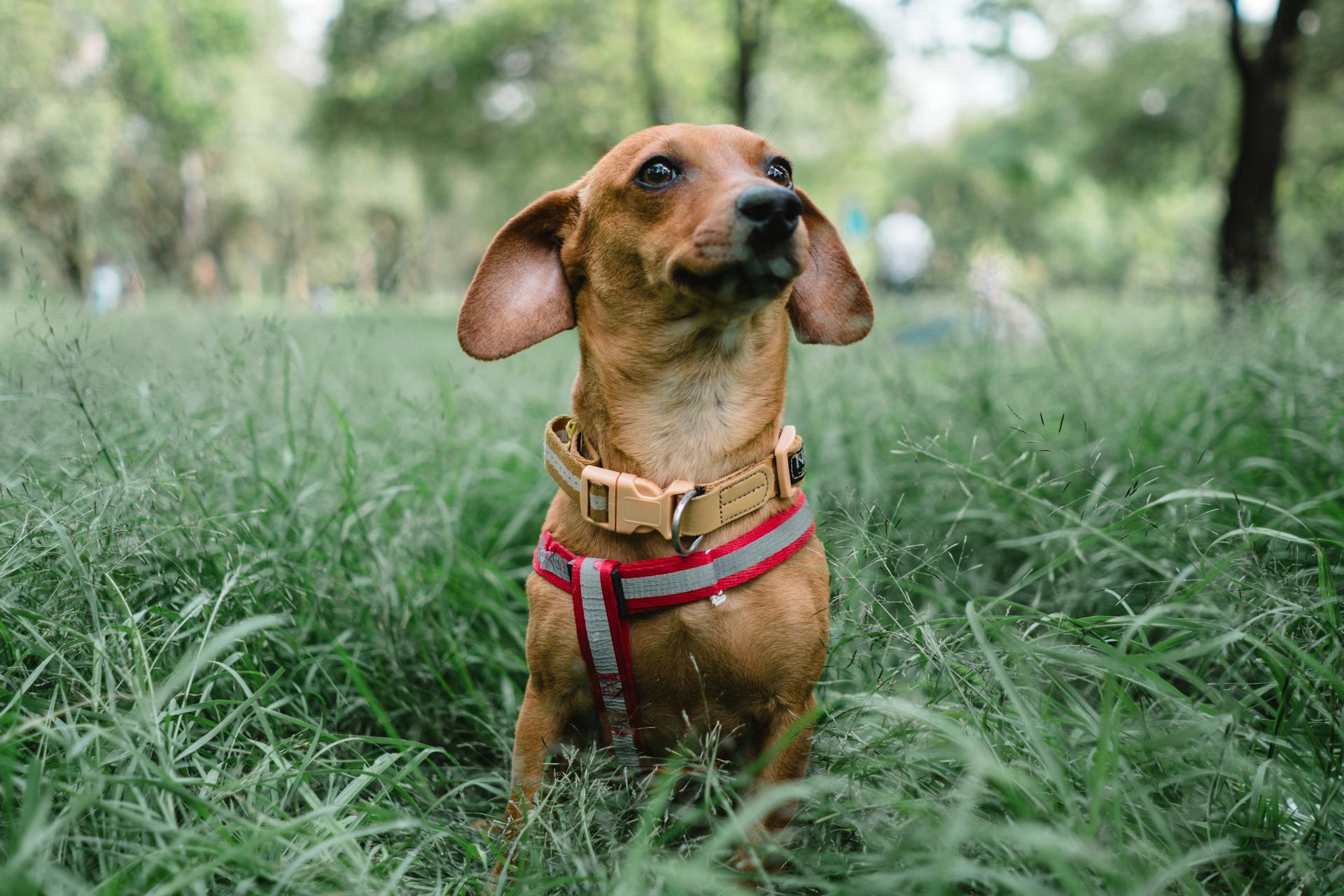
Dog fence aggression is a common issue that can be caused by a variety of factors, including territorial behavior, fear, and anxiety.
In some cases, dogs may become aggressive when they feel trapped or confined in their own yard, leading to destructive behavior and potential harm to themselves or others.
Preventing dog fence aggression starts with understanding the root causes of the behavior, which can be addressed through proper training, socialization, and environmental enrichment.
To effectively address dog fence aggression, it's essential to identify the underlying triggers and take steps to mitigate them, such as providing adequate exercise and mental stimulation.
Causes and Signs of Aggression
Dog fence aggression can be a frustrating issue for pet owners. A dog's behavior behind a fence can be a sign of underlying emotions, such as fear, overexcitement, stress, anxiety, or frustration.
Barking, growling, jumping, lunging, and other reactions to stimuli from behind a barrier are considered barrier frustration. This can be triggered by a variety of things, including humans, other dogs, passing vehicles, sounds, or even flapping objects.
In many cases, barrier frustration is not aggression, but rather a result of the dog's emotional state.
Curious to learn more? Check out: Dog Barrier Aggression
Preventing Reactivity and Frustration
Preventing reactivity and frustration is key to addressing dog fence aggression.
To prevent barrier frustration, you can block your dog's visual access to the stimuli outside his fences, which can reduce the likelihood of undesirable behaviors.
Minimizing visual and audio access will help to decrease your dog's stress level, making your training much easier.
By removing triggers, such as people, other dogs, or vehicles, you can reduce your dog's stress and anxiety.
Covering the view by putting up visual barriers along the fence line or closing the curtains can also help.
Take a look at this: Does Cbd Help with Dog Aggression
Signs of Frustration
A dog barking, growling, jumping, lunging, or reacting to something from behind a barrier is considered barrier frustration.
The gate, fence, door, or window acts as a barrier separating the dog from the trigger or stimulus to which they're reacting.
The trigger or stimulus could be a human, another dog, a passing vehicle, a particular sound, or even something flapping in the breeze.
Barrier frustration is often rooted in fear, overexcitement, stress, anxiety, or frustration.
A dog's reaction to a trigger from behind a barrier is not always aggression, but rather a sign of underlying emotional distress.
Preventing Reactivity and Frustration
Barrier frustration is a common issue in dogs, characterized by barking, growling, jumping, lunging, or reacting to something from behind a barrier. This can be a gate, fence, door, or window, and the trigger can be a variety of things, including humans, other dogs, vehicles, sounds, or even flapping objects.
The key to preventing barrier reactivity is to minimize visual and audio access to the trigger. This can be achieved by blocking your dog's view and reducing the noise level. For example, you can put up visual barriers along the fence line or close the curtains to block the view.
Preventing fence aggression and barrier frustration can be achieved by blocking your dog's visual access to the stimuli outside his fences. This will reduce the likelihood and opportunity for fence running and fighting.
Dogs are learning through every experience and interaction they have, so it's essential to set them up for success by not giving them the chance to react to a trigger. You can do this by arranging their environment to prevent reactivity, such as putting them in another room before guests arrive.
Management is often the best solution when it comes to preventing barrier reactivity. This can include blocking your dog's view, reducing noise levels, and distracting them with soothing music or treats.
Retraining a Dog
Retraining a dog with fence aggression requires patience, understanding, and a solid training plan. You can't just stand in front of your dog and expect them to snap out of it, as they'll likely dart around you and continue their mission.
To counter-condition your dog to the presence of arousal-causing stimuli, you'll need to find a way to get their attention and break their focus. Tossing treats or balls might not work, but a two-pronged training program can help. This involves improving your dog's recall response, even in the face of high distractions.
Preventing barrier reactivity in dogs starts with minimizing visual and audio access to the stimulus or trigger. By doing so, you can decrease your dog's stress level and make training much easier. This is a crucial first step in addressing fence aggression.
Helping a dog overcome barrier frustration requires a calm and gentle approach. Use high-value treats and a long line to encourage your dog to come to you, even in the face of distractions. Start by moving backward from your dog, calling their name and the cue "come!" in a fun tone.
Here are some key tips to keep in mind when retraining a dog with fence aggression:
- Always use a calm, gentle tone.
- Keep sessions short: five minutes or less at first.
- Remember to take breaks and provide your dog with a fun activity, such as playing catch or sniffing around the yard.
- Be patient but optimistic, as progress might be slow but will happen.
By following these tips and using techniques like counter-conditioning, you can help your dog overcome barrier frustration and learn to respond to triggers in a more positive way.
Managing Aggression with E-Collars and Fencing
Preventing barrier reactivity in dogs is crucial to avoiding aggression, so minimizing visual and audio access can greatly decrease your dog's stress level.
You can start by assessing ways to prevent your dog from noticing the stimulus or trigger, and then work on positive reinforcement techniques to alleviate stress.
A solid fence can be an effective management tool to prevent barrier aggression, especially if you can't be present to interrupt your dog's behavior.
However, prevention is always the best course of action, and not leaving your dog fenced and unattended can prevent the development of barrier aggression in the first place.
Explore further: Prevent Dog
If you're dealing with a severe case of barrier aggression, consider consulting a positive behavior consultant or veterinary behaviorist for professional help.
Here are some key takeaways to keep in mind when managing aggression with e-collars and fencing:
- Prevention is key: block your dog's view and minimize visual and audio access to the trigger.
- Management is crucial: use a solid fence or other barriers to prevent access to the trigger.
- Be patient and optimistic: progress may be slow, but it will happen with consistent training and management.
- Don't punish your dog for reacting: instead, focus on positive reinforcement techniques to change their perception of the trigger.
Canine Aggression Treatment
Prevention is the best course of action when it comes to dog fence aggression. By not leaving your dog in a position to develop the behaviors in the first place, you can avoid the frustration and stress that comes with it.
Management is also a crucial aspect of treating canine aggression. A solid fence can help to block your dog's view and reduce their stress levels, making it easier to manage their behavior.
If your dog is already exhibiting fence-related behaviors, counter-conditioning can be an effective technique to use. This involves changing how your dog feels about the trigger, such as another dog passing by, from something anxiety-provoking to something good and pleasing.
Additional reading: Dog Aggression When Someone Comes to the Door
To start counter-conditioning, you'll need to work on recall. This means teaching your dog to come to you when called, even in the face of distractions. You can use high-value treats and a long line to make this process easier.
Here are some key steps to follow when working on recall:
- Start by moving backward from your dog while facing them, saying their name followed by the cue "come!"
- As your dog starts to run toward you, reel in the long line and mark the behavior with a "yes" or a click from a clicker followed by a treat.
- Continue to practice this in different environments and with different distractions, phasing out the long line as you go.
Once your dog's recall is solid, you can proceed with modification for the reactivity. This involves practicing the cue "come" in the location where your dog displays reactivity, even if there isn't a stimulus or trigger present.
Some important tips to keep in mind when working on behavior modification:
- Always use a calm, gentle tone.
- Keep sessions short: five minutes or less at first.
- Remember to take breaks and stop and take the dog out for a walk, or think of another activity your dog might enjoy.
- Be patient but optimistic. Progress might be slow, but it will happen.
Ultimately, the key to treating canine aggression is to be patient, consistent, and positive. With time and practice, you can help your dog overcome their fence-related behaviors and live a happier, healthier life.
Frequently Asked Questions
How to get a dog to stop running along a fence?
Restrict your dog's access to the fence by using a temporary double fence, blocking their path, or keeping them in a den or crate when unsupervised
Sources
- https://robinmacfarlane.com/aggression-in-dogs/
- https://resources.bestfriends.org/article/how-manage-dog-barrier-aggression-and-frustration
- https://saraondrako.com/youtube/how-to-fix-barrier-aggression-in-dogs/
- https://www.whole-dog-journal.com/behavior/leash-barrier-reactivity/solve-fence-aggression-with-a-better-dog-fence/
- https://resources.bestfriends.org/article/managing-barrier-reactivity
Featured Images: pexels.com


